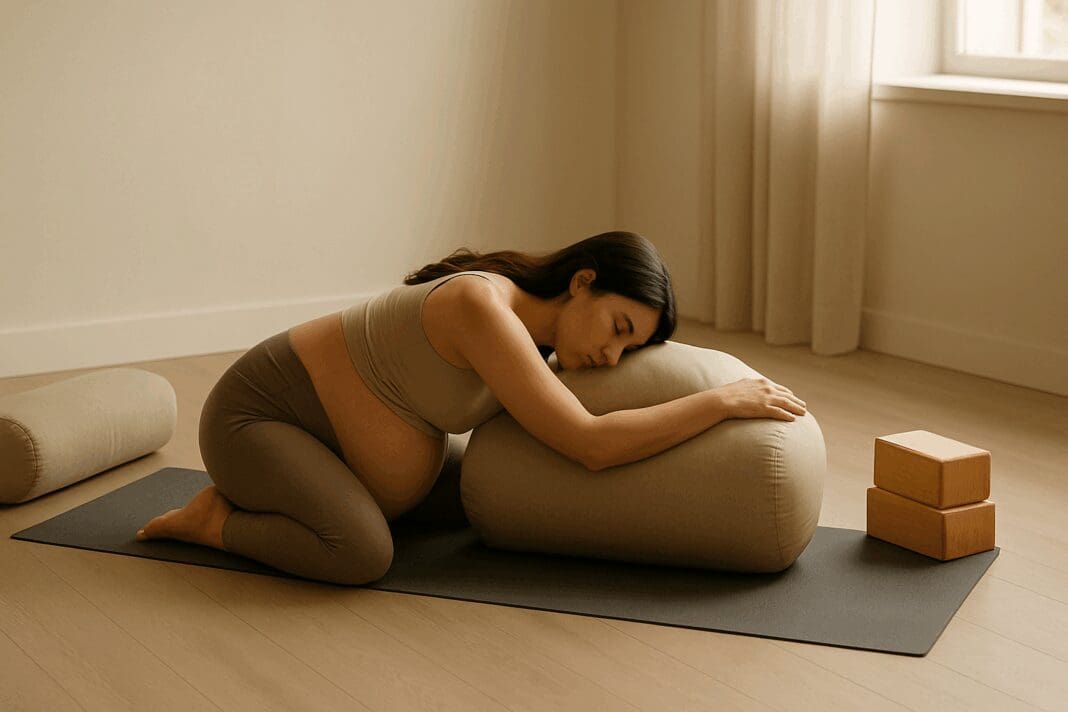Entering the third trimester is a pivotal milestone in any pregnancy journey, marked by both anticipation and physical transformation. As the body prepares for labor and delivery, maintaining strength and comfort becomes increasingly important. One of the most accessible and effective ways to nurture both physical well-being and emotional balance during this stage is through yoga. Practicing yoga positions for pregnancy third trimester offers expecting mothers a practical tool to ease discomfort, enhance circulation, and maintain a connection to their changing bodies in a deeply empowering way.
Yoga during the final trimester is not just about movement—it’s a holistic practice that encourages mental clarity, breath control, and muscle engagement tailored to the unique demands of late pregnancy. Unlike earlier trimesters, when energy levels might be higher and mobility less restricted, the third trimester calls for a modified and more mindful approach. In this context, gentle yet purposeful movements aligned with the principles of prenatal fitness become invaluable. Pregnant individuals must honor their body’s cues and engage in yoga positions that support their growing bellies, shifting center of gravity, and the profound anatomical changes underway.
You may also like: The Ultimate Guide to Safe and Effective Pregnant Yoga Classes for Expecting Moms
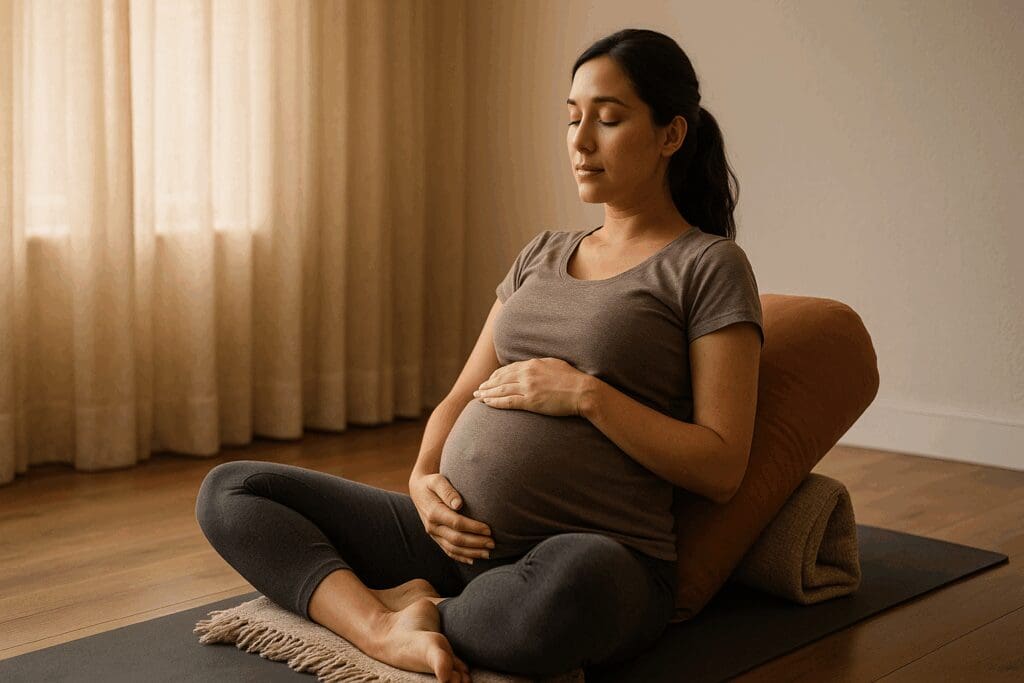
Understanding Third Trimester Needs: The Foundation of Prenatal Yoga
The third trimester, typically spanning from week 28 to delivery, is often characterized by increased fatigue, lower back discomfort, swelling in the extremities, and heightened emotional sensitivity. It is a period of preparation as the baby rapidly gains weight and the uterus expands to accommodate this growth. As a result, there is increased pressure on the pelvic floor, spine, and major joints. Yoga and pregnancy third trimester go hand-in-hand as a supportive modality, designed to alleviate tension and help the body adapt more gracefully to these physiological shifts.
Practicing yoga in the third trimester can also have profound psychological benefits. Breathwork, or pranayama, enhances oxygen flow to the baby while simultaneously calming the nervous system. Mindful movement improves circulation, reduces the risk of varicose veins and leg cramps, and helps maintain flexibility. Emotional regulation through yoga becomes especially relevant as the birth date approaches, providing a sense of agency and inner peace during a time of uncertainty.
When crafting a third trimester yoga routine, it is essential to focus on safety and sustainability. Emphasis should be placed on grounding poses, gentle hip openers, and restorative postures that do not require lying flat on the back for extended periods. By adapting sequences to reflect the specific needs of this trimester, yoga remains an inclusive and empowering tool for every pregnant individual.

Gentle Yet Effective: Ideal Yoga Positions for Pregnancy Third Trimester
Among the most suitable yoga positions for pregnancy third trimester are those that prioritize balance, stability, and space for the abdomen. These poses are designed to strengthen essential muscle groups while relieving common areas of discomfort.
One foundational pose is the modified Cat-Cow stretch, which promotes spinal flexibility and relieves pressure from the lower back. It also encourages pelvic mobility, which can be helpful in preparing for labor. Standing poses such as Warrior II and Goddess Pose, when performed with support, are excellent for building leg strength and stamina without straining the core.
The use of props becomes increasingly important in the third trimester. Bolsters, blocks, and chairs can assist in adapting traditional yoga poses into accessible versions that maintain proper alignment and support. Poses such as Supported Child’s Pose and Reclined Bound Angle Pose offer deep relaxation while enhancing hip flexibility and pelvic opening. These positions also help alleviate tension from the hips and inner thighs, areas that often become tight due to postural changes.
As the belly grows, balance can become more challenging, so incorporating wall support or practicing on a non-slip mat is highly recommended. Transitions between poses should be slow and intentional to prevent dizziness or instability. The goal is not to achieve deep stretches or advanced postures but rather to move mindfully, breathe deeply, and maintain an open and receptive state.
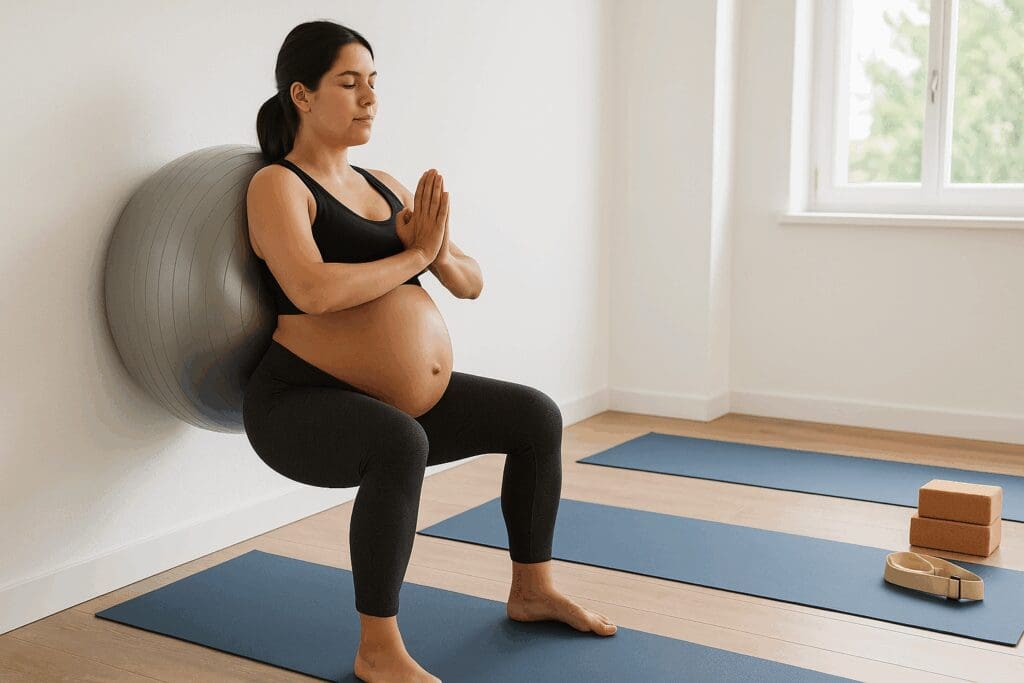
3rd Trimester Prenatal Yoga Poses That Support Strength and Resilience
Practicing 3rd trimester prenatal yoga poses that emphasize gentle resistance and functional movement patterns can go a long way in supporting the pregnant body through its final phase of gestation. These yoga practices are not merely about exercise; they serve as a bridge between physical endurance and emotional fortitude, helping mothers-to-be prepare both mentally and physically for the birthing process.
One such pose is the Wall Sit, which can be modified for pregnancy by placing a stability ball between the back and the wall. This pose strengthens the quadriceps, glutes, and pelvic floor muscles, all of which play a vital role in labor and delivery. Another beneficial pose is the Squat, or Malasana, which opens the hips and stretches the lower back. This position, when supported with a block or bolster, can be held for extended periods to build endurance and flexibility.
Incorporating gentle lunges, such as Low Lunge or Crescent Lunge with support, enhances hip mobility and leg strength. These postures mimic the actions needed during childbirth, making them particularly relevant to prenatal preparation. The use of breath control during these movements further enhances their benefits, turning each lunge into a meditative experience that grounds the mind and energizes the body.
Even seated positions, such as Wide-Legged Forward Fold or Butterfly Pose, can contribute significantly to resilience by encouraging pelvic expansion and hamstring flexibility. These poses not only counteract the physical restrictions of pregnancy but also foster a deeper sense of self-awareness. They remind the practitioner that strength during the third trimester is as much about endurance and patience as it is about muscular power.
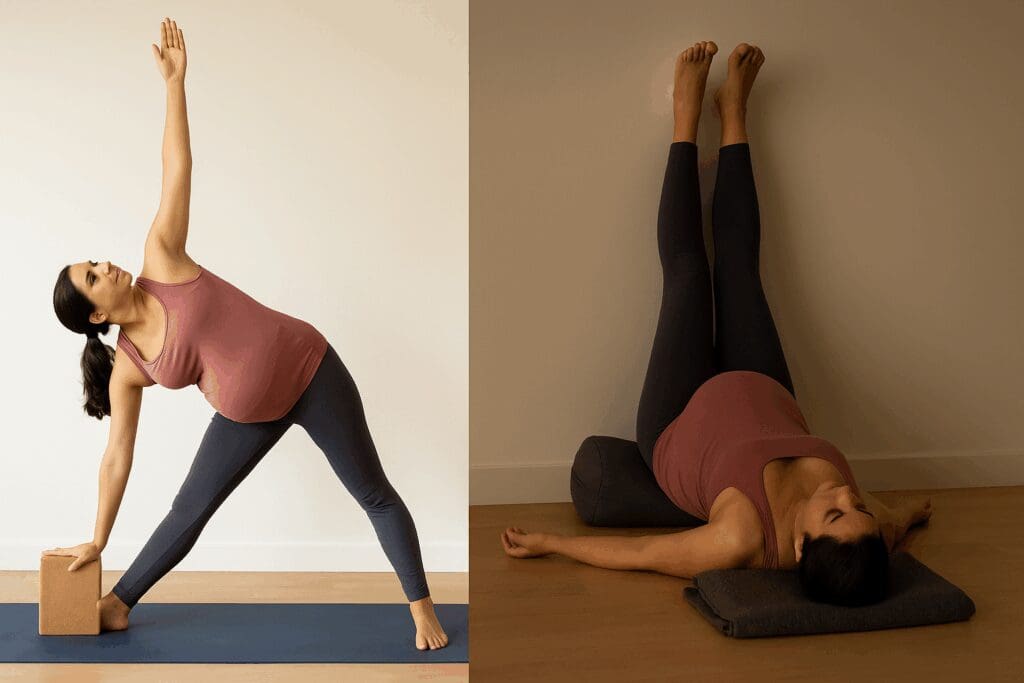
Balancing Energy and Relaxation Through Third Trimester Yoga
One of the most delicate balances to achieve in third trimester yoga is between maintaining energy and cultivating relaxation. While some days may call for invigorating sequences that awaken the body, others may necessitate restorative practices that promote rest and recovery. This variability is normal and should be embraced as part of the prenatal journey.
Restorative yoga practices using props are particularly valuable during the third trimester. Poses such as Legs Up the Wall or Reclined Hero Pose, when properly supported, allow for deep relaxation and reduced swelling in the legs and feet. These positions also support lymphatic drainage and can ease symptoms of fatigue or insomnia, which are common in the final weeks of pregnancy.
Breathwork continues to be a cornerstone of third trimester yoga. Practices such as three-part breath, alternate nostril breathing, or simple diaphragmatic breathing can be integrated into any yoga session to regulate energy and promote emotional balance. These techniques not only prepare the body for labor but also serve as tools for managing discomfort and anxiety.
A typical session that blends energizing and relaxing elements might begin with seated breathwork, move into gentle standing flows with poses like Side Angle Stretch and Modified Triangle, and conclude with supported restorative postures. This structure allows the practitioner to experience both movement and stillness, reinforcing the duality of strength and surrender inherent in the prenatal experience.
Expert Tips for Practicing 3rd Trimester Yoga Poses Safely
Safety remains paramount when exploring 3rd trimester yoga poses, and expert guidance can make all the difference in optimizing the experience. First and foremost, it is essential to consult with a healthcare provider before beginning or continuing any yoga routine during pregnancy, particularly in the final trimester. Once cleared for practice, the focus should shift toward customization, with each session tailored to the individual’s comfort level and physical capabilities.
Avoiding deep twists, intense backbends, and poses that compress the abdomen is a standard guideline during this phase. Instead, open twists and gentle spinal extensions can be performed with modifications to maintain alignment and avoid undue pressure. For example, instead of a traditional seated twist, a modified version with the torso facing forward and a gentle rotation of the shoulders is more appropriate.
It is equally important to avoid lying flat on the back for extended periods, as this can compress the vena cava and reduce blood flow. Supine poses should be modified with a bolster or wedge under one side to create a gentle incline. Transitions between poses must be deliberate and slow, reducing the risk of lightheadedness or imbalance due to shifts in blood pressure and center of gravity.
Hydration and ventilation are additional considerations. Pregnant individuals may overheat more quickly, so practicing in a cool, well-ventilated space with access to water is advisable. Clothing should be breathable and supportive, allowing for freedom of movement without restricting the growing belly.
Perhaps most importantly, yoga in the third trimester should be a judgment-free practice. There is no ideal pace or pose to achieve. What matters most is how the individual feels in their body—supported, grounded, and connected. Listening to one’s internal cues, rather than external expectations, becomes the guiding principle of a safe and nourishing yoga journey.
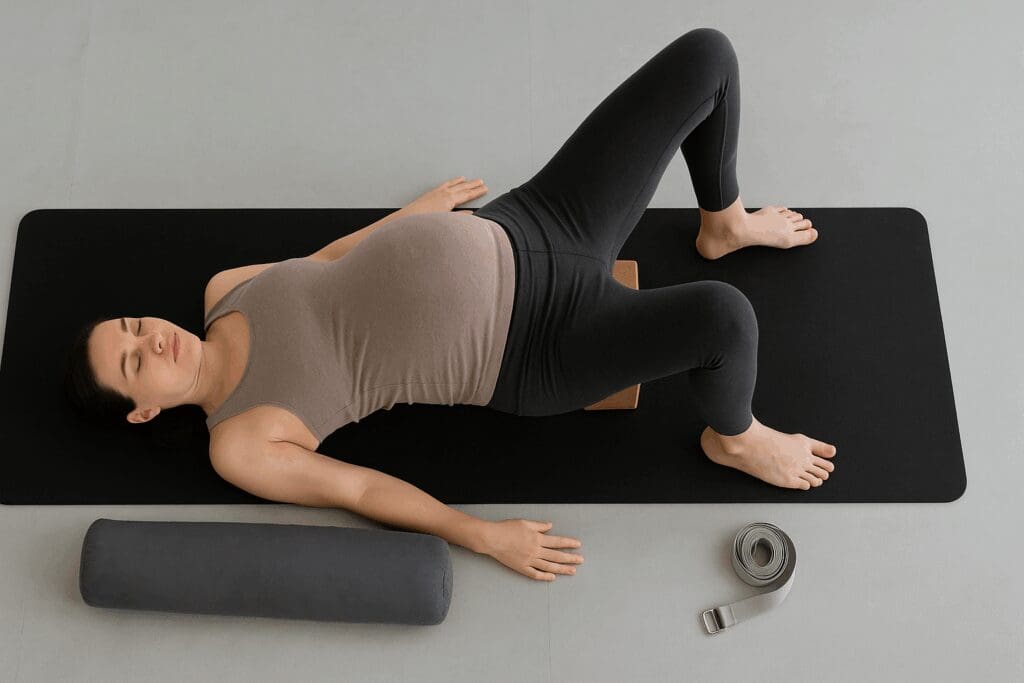
Enhancing Pelvic Floor Strength with Yoga Poses for Pregnancy Third Trimester
A vital aspect of prenatal fitness that often receives less attention is pelvic floor health, and yoga poses for pregnancy third trimester provide an excellent opportunity to strengthen this foundational muscle group. The pelvic floor supports the uterus, bladder, and bowel and plays a critical role in childbirth and postpartum recovery. Integrating specific yoga movements that enhance pelvic awareness and engagement can make a significant difference in maternal comfort and function.
Bridge Pose, when modified and supported, is a valuable posture for engaging the pelvic floor. Lifting the hips while maintaining stability strengthens both the glutes and the deeper pelvic muscles. While this pose is often performed dynamically in traditional yoga, during the third trimester it is best practiced with props and longer holds to encourage slow, mindful activation.
Kegel exercises can also be integrated seamlessly into seated yoga poses, such as Easy Pose or Hero Pose. By combining breath awareness with intentional pelvic contractions, practitioners can build strength and coordination in this often-overlooked area. These exercises are subtle yet powerful, and their integration into a yoga routine promotes continuity and efficiency.
Another helpful position is the supported Squat, which gently stretches the pelvic floor while increasing blood flow to the perineal region. Holding this pose with the assistance of a block or wall not only prepares the body for birthing positions but also improves flexibility in the hips and thighs. As always, ensuring that the pelvis remains aligned and that pressure is evenly distributed is crucial for safety and efficacy.
The benefits of pelvic floor engagement extend beyond physical preparation for labor. Strong, responsive pelvic muscles can improve urinary continence, support postpartum healing, and contribute to overall core stability. Thus, integrating pelvic floor awareness into yoga practice during the third trimester becomes a vital component of holistic maternal care.
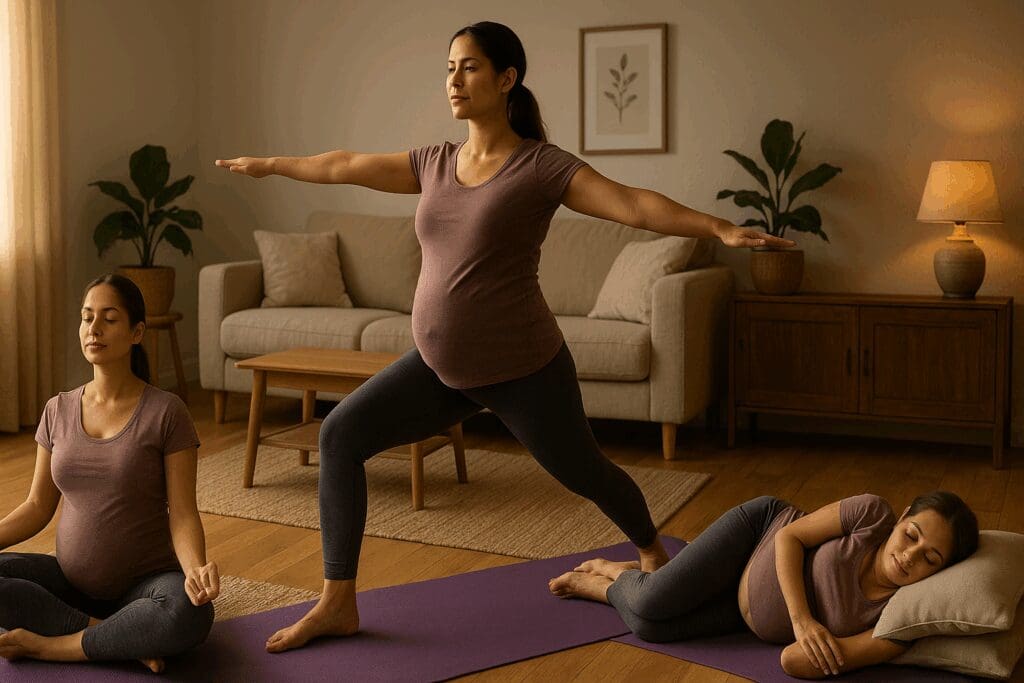
Adapting Yoga Practice to Daily Needs in the Final Trimester
Each day in the third trimester can feel different, and yoga practice should reflect this dynamic reality. Some mornings may be marked by stiffness or fatigue, while afternoons might bring bursts of energy or emotional fluctuation. The adaptability of yoga makes it a perfect companion during this unpredictable time, offering a variety of options to meet changing needs.
Creating a flexible practice plan that includes different types of sessions—energizing, restorative, and hybrid—can help sustain consistency without creating pressure. For example, a ten-minute seated breathing practice may be more beneficial on a low-energy day than pushing through a full sequence. On more active days, a flowing series of standing poses with integrated breathwork can provide a welcome boost.
It is also helpful to have a set of go-to postures that can be practiced at any time of day without requiring much space or equipment. Poses like Supported Forward Fold, Side-Lying Savasana, and Wall-Assisted Squat can be incorporated into short, frequent sessions to reduce stiffness, promote circulation, and relieve tension.
The ability to adapt is one of yoga’s greatest strengths. In the third trimester, where predictability is rare, this flexibility becomes not just convenient but essential. Yoga does not demand perfection or performance; it offers presence. And in the final weeks of pregnancy, presence is often the most profound gift one can give oneself.
Yoga and Pregnancy Third Trimester: A Holistic Perspective on Well-Being
Taking a holistic view of yoga and pregnancy third trimester reveals a broader tapestry of benefits that extend beyond the physical. Emotional resilience, spiritual connection, and maternal identity all find a nurturing ground in prenatal yoga. The mat becomes more than a place for stretching—it is a sanctuary for growth, transformation, and inner alignment.
Journaling after yoga sessions can enhance this holistic experience, offering space to process emotions, reflect on bodily sensations, and set intentions for the day or week. Some practitioners also incorporate visualization techniques during relaxation poses, imagining their baby’s peaceful presence or mentally rehearsing a calm and empowered birth.
Connection with community is another vital element. Joining prenatal yoga classes, whether in-person or virtual, fosters a sense of solidarity and shared experience. It reminds expectant mothers that they are not alone in their journey and that their challenges, fears, and hopes are part of a collective narrative.
This broader perspective reinforces the idea that yoga in the third trimester is not solely a physical endeavor. It is a practice of coming home to oneself during a time of immense change. By cultivating strength, releasing tension, and nurturing stillness, yoga supports the full spectrum of well-being for both mother and baby.
Yoga Positions for Pregnancy Third Trimester: Embracing the Path to Birth with Confidence
As the journey of pregnancy reaches its final chapter, embracing yoga positions for pregnancy third trimester becomes a powerful affirmation of readiness and trust. These poses are not just exercises; they are expressions of confidence, preparation, and surrender. With each movement, breath, and moment of stillness, the expectant mother is cultivating not only physical capacity but also emotional resilience and mental clarity.
This stage of yoga practice is deeply intimate and personal. Whether it involves a daily 30-minute sequence or a five-minute meditation before bed, the impact is profound. The body is being prepared for the rigors of labor, but just as importantly, the mind and heart are being nurtured to face the unknown with grace.
Pregnancy, particularly the third trimester, can bring about vulnerability, excitement, and a longing for control. Yoga answers these emotional needs with presence, reminding practitioners that even amidst discomfort and uncertainty, they have the tools to ground, breathe, and move forward. It reinforces the message that strength is not merely about muscle but about self-awareness, compassion, and the ability to let go.
As birth approaches, yoga provides a space for both reflection and intention-setting. It becomes a ritual of self-care that honors the body’s wisdom and the sacredness of the birthing process. In this way, the third trimester is not only an end but a beginning—a bridge between two worlds, held and supported by the timeless practice of yoga.
Frequently Asked Questions: Expert Insights on Third Trimester Yoga Practice
What should I do if I experience discomfort while practicing third trimester yoga?
Discomfort during third trimester yoga is not uncommon, but it’s essential to distinguish between productive sensation and warning signs of strain. Rather than pushing through, modify the pose immediately or shift to a restorative position like Side-Lying Savasana or Supported Child’s Pose. Pregnant bodies vary in flexibility and joint stability, particularly due to the effects of the hormone relaxin, which increases ligament laxity. Using props such as bolsters, straps, and blankets can help ease pressure on joints and provide a more stable base for movement. Additionally, maintaining open communication with your prenatal yoga instructor about any recurring discomfort can lead to more personalized modifications and a safer experience overall.
How often should I practice yoga positions for pregnancy third trimester?
A consistent but flexible schedule is most beneficial for third trimester yoga. Practicing yoga positions for pregnancy third trimester three to five times per week allows you to maintain flexibility, support circulation, and manage emotional well-being without overexertion. Each session doesn’t need to be long—short, 15-minute daily routines that blend breathwork and gentle movement can be just as effective as a single extended session. It’s important to tune into how you feel each day; if you’re particularly tired or sore, a restorative or breath-focused session may be more appropriate than an active one. Incorporating yoga into daily life as a tool for body awareness and calmness, rather than as a rigid workout, leads to more sustainable and intuitive practice during the third trimester.
Are 3rd trimester prenatal yoga poses safe for those with previous injuries?
Many 3rd trimester prenatal yoga poses can be safely adapted for individuals with a history of injuries, particularly when those injuries involve the spine, hips, or knees. The key is to maintain a focus on alignment and support. For instance, someone with past lower back issues may benefit more from seated poses supported by cushions rather than standing sequences. A history of knee problems might require using extra padding or avoiding deep squats altogether. Yoga and pregnancy third trimester work best when the emphasis is placed on gentle strength and mindfulness, not range of motion. Consulting with a physical therapist or prenatal-certified yoga instructor familiar with injury adaptations ensures a balance between therapeutic movement and injury prevention.
How can I modify 3rd trimester yoga poses if I have trouble getting up and down from the floor?
As pregnancy advances, mobility can become more limited, especially when transitioning between floor and standing poses. One solution is to practice sequences entirely on an elevated surface like a firm bed or padded bench, which can minimize strain. You can also focus on chair-based third trimester yoga, which maintains many of the benefits of traditional poses while offering greater stability and ease of access. Props like sturdy yoga blocks and bolsters can act as intermediate steps, reducing the physical effort required to shift positions. Yoga poses for third trimester should never leave you feeling strained or unsupported—your practice can and should evolve to match your changing body, even if that means staying seated for the entire session.
What are some lesser-known emotional benefits of yoga during the third trimester?
While many people associate yoga with physical fitness, third trimester yoga also fosters deep emotional resilience. The breath control techniques learned on the mat can be used during challenging emotional moments to self-regulate anxiety and overwhelm. In group settings, prenatal yoga provides a space to connect with others experiencing similar transformations, reducing feelings of isolation. Some practitioners also report that repeating positive mantras during poses creates a sense of empowerment and self-compassion, which can carry into labor and early parenthood. These emotional tools, cultivated through consistent yoga practice, support not only the immediate transition of childbirth but also the long-term mental health of new mothers.
Can yoga poses for pregnancy third trimester help with sleep difficulties?
Yes, practicing yoga poses for pregnancy third trimester can significantly enhance sleep quality, especially when integrated into a bedtime routine. Gentle stretches before bed, such as Reclined Butterfly Pose or Legs Up the Wall, can reduce swelling and soothe restless legs—two common culprits of poor sleep in late pregnancy. Slow, rhythmic breathing paired with mindful movement lowers cortisol levels, making it easier to fall and stay asleep. Incorporating a consistent nighttime yoga ritual also helps signal to the body that it’s time to transition into rest mode. Even five to ten minutes of third trimester yoga focused on relaxation can be more effective than passive rest when combating pregnancy-related insomnia.
What is the best way to integrate 3rd trimester yoga poses into a busy lifestyle?
The most effective way to integrate 3rd trimester yoga poses into a packed schedule is to reframe the practice as a modular experience. You don’t need an hour of uninterrupted time to benefit—two 10-minute sessions spread across the day can deliver similar results. Morning sequences can focus on energizing breathwork and gentle movement to counter morning stiffness, while evening practices can emphasize grounding and relaxation. Having a set of go-to poses ready for various moods and energy levels makes it easier to stay consistent. Whether you choose yoga and pregnancy third trimester sessions at home, in a studio, or on the go, the flexibility of yoga means it can be tailored to any schedule without sacrificing impact.
Are there cultural or spiritual elements in third trimester yoga that may support emotional growth?
Yes, many traditions within prenatal yoga draw from ancient yogic philosophies that emphasize surrender, patience, and divine connection—qualities that align beautifully with the journey of late pregnancy. Chanting or meditating on sounds like “Om” can foster a deep sense of grounding, while setting an intention (or sankalpa) at the beginning of each session can bring clarity to the emotional and spiritual aspects of birth preparation. Some people integrate elements from Bhakti Yoga, the yoga of devotion, into their practice by visualizing a peaceful labor or expressing gratitude for their evolving body. These spiritual components, though optional, can deepen the meaning of third trimester yoga beyond its physical and mental benefits, creating a holistic experience of growth and transformation.
How can I personalize yoga positions for pregnancy third trimester if I am expecting twins?
Expecting twins during the third trimester presents unique physical challenges, including greater abdominal weight, increased fatigue, and heightened pelvic pressure. In such cases, personalizing yoga positions for pregnancy third trimester is critical. Focus on reclined and side-lying poses that reduce spinal compression, and avoid long periods in upright postures without support. Double the use of props to maintain stability and safety—bolsters, cushions, and wall support should become staples in your practice. Consider replacing sequences that require deep engagement of the core with gentle breathwork and hip-opening positions that release tension. Remember, the purpose of 3rd trimester prenatal yoga poses when carrying multiples is not to do more but to support your body’s extraordinary effort with deliberate, nurturing movement.
Can yoga poses for third trimester influence postpartum recovery?
Absolutely. Many yoga poses for third trimester actively prepare the body and mind for smoother postpartum recovery. Strengthening the pelvic floor and maintaining hip mobility during late pregnancy can lead to better tissue resilience and faster healing after delivery. Moreover, the breathing patterns learned in third trimester yoga often serve as tools for managing postpartum anxiety and fostering presence during newborn care. Certain poses like Supported Bridge or Gentle Seated Twists (reintroduced after birth with clearance) can gradually ease the body back into movement without overwhelming it. Additionally, third trimester yoga helps create a body-awareness foundation that empowers new mothers to detect their physical needs more intuitively during recovery, promoting sustainable self-care and long-term wellness.
The Path Forward: How Yoga Poses for Third Trimester Can Empower Every Pregnancy
In conclusion, exploring yoga poses for third trimester is more than a prenatal exercise regimen—it is an invitation to deepen the relationship with one’s body, to prepare with purpose, and to honor the journey of motherhood. From building pelvic strength to fostering emotional equilibrium, the benefits of yoga extend far beyond the mat.
These practices cultivate a sense of empowerment that is vital for childbirth and the postpartum experience. As each pose is explored, each breath taken, and each intention set, expecting mothers are reminded of their resilience, adaptability, and inner power. The lessons learned in prenatal yoga—patience, presence, and self-trust—become invaluable tools in the transition to parenthood.
Ultimately, the integration of yoga into the third trimester experience provides not only physical relief but also a meaningful framework for navigating change with grace. It affirms that amidst the whirlwind of preparations and emotions, there is a still, strong center within each individual. And through the consistent practice of yoga positions for pregnancy third trimester, that center becomes both a refuge and a source of strength, guiding mother and baby toward birth with clarity, courage, and comfort.
Further Reading:
Pregnancy Yoga Poses for the Third Trimester
Prenatal Yoga Poses for Every Trimester
These Are the Prenatal Yoga Poses to Try During Each Trimester

